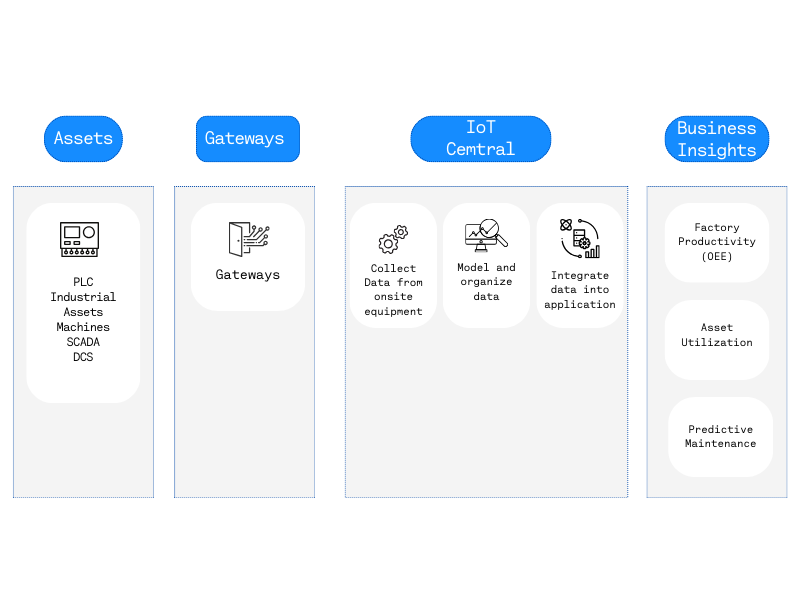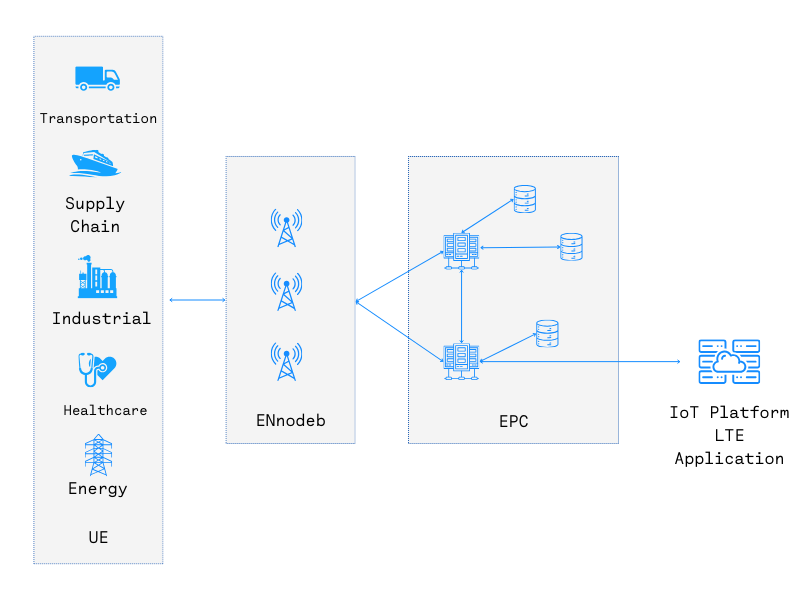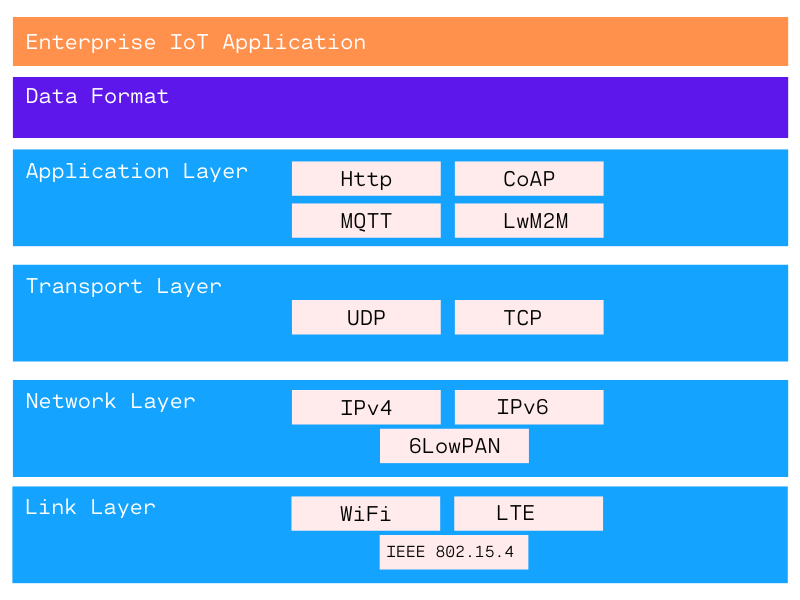[vc_row][vc_column][vc_single_image source=”featured_image” img_size=”full”][vc_column_text]
Demystifying IoT
The term “IoT” (Internet of Things) often surfaces in discussions, yet its actual structure and underpinnings are not that familiar. This blog post explains what exactly an IoT device is, how it connects, and the technologies involved. We often hear about IoT, but how many truly understand its architecture or could even sketch it out?
The Essence of IoT Architecture

At a high level, the basic architecture of an IoT device is surprisingly universal, independent of its application. This structure provides a look at the system, highlighting how an IoT solution integrates various components.
- Device Component: At the heart of any IoT solution is the device component. It’s responsible for collecting vital data such as location, temperature, acceleration, and other remote monitoring information. This data is transmitted through various wireless technologies like LoRa, Wi-Fi, or cellular networks using specific messaging protocols via an IP-based network.
- Communication Needs: While some applications might only require one-way communication, most need bidirectional capabilities. For instance, remotely switching on machinery or sending configurations to devices to alter the sensory data transmission intervals.
Delving Into Layers: IoT Protocol Stack
- Link Layer: The foundational layer of the IP protocol stack for IoT, encompassing radio technologies like Wi-Fi, LoRa, LTE, and 5G, as well as wired connections like Ethernet. This layer is crucial in defining how devices access the IP network, acting as the bridge to the network layer.
- Network Layer: Here, data is packaged and sent across the internet using standard IP, either IPv4 or IPv6. With IPv4 addresses running low, there’s a gradual shift toward IPv6. The 6LoWPAN standard, designed for low-power devices, adapts to technologies like Bluetooth and Wi-Fi, ensuring interoperability with IPv6.
- Transport Layer: TCP, a connection-oriented protocol, manages data flow control and error detection, while UDP, a connection-less protocol, is simpler and faster but lacks error correction. TCP is widely used for internet and IoT data traffic, while UDP is preferred for IoT solutions needing fewer network resources and no constant device connection.
- Application Layer: Analogous to an internet browser, this layer implements protocols like HTTP or FTP. For resource-constrained IoT devices, HTTP can be too demanding, paving the way for IoT-specific protocols like MQTT, CoAP, and LwM2M.
- Data Format: IoT devices use various data formats, with binary, JSON, CBOR, and Protocol Buffers (protobuf) being prominent. Protobuf, developed by Google, stands out for its compact structure and multi-language code generation capabilities, offering data size efficiency essential in resource-limited environments.
Connectivity: LTE

The Role of 4G LTE in IoT Devices
4G LTE (Long-Term Evolution) technologies are increasingly pivotal in the realm of the Internet of Things (IoT), each category catering to specific IoT applications. Here’s a closer look at the various LTE categories and their roles in IoT:
- Category 1 (CAT 1): CAT 1 is ideal for IoT applications involving a single device with a main power source, such as kiosks and security cameras. This category offers a balanced mix of speed and power efficiency, suitable for stationary IoT devices that require constant connectivity.
- Categories 3/4 (CAT 3/4): Offering higher speeds, CAT 3 and CAT 4 are perfect for IoT routers that connect multiple devices. These categories are designed for more data-intensive applications, where rapid data transmission and processing are key.
- Category M or LTE-M (CAT-M/LTE-M) and NB-IoT: CAT-M/LTE-M is tailored for 2G-like applications and mobile devices, while NB-IoT is the go-to choice for battery-operated, stationary devices. The implementation of LTE-M or NB-IoT as secondary networks adds complexity to the decision-making process for operators, particularly in balancing coverage and power efficiency.
The LTE Network Architecture in IoT
The LTE network architecture plays a crucial role in IoT solutions. A high-level diagram of this architecture starts with an IoT device, known as User Equipment (UE), and explains the process of accessing and transmitting data over the LTE network, including the roles of various network components.
1) The UE (User Equipment)
The UE, or IoT device, must be compatible with specific LTE technology and frequency bands and possess authorized LTE operator credentials (e.g., AT&T or Verizon), stored in the device’s Subscriber Identity Module (SIM). These compatible UEs connect to the nearest LTE Evolved Node B (eNodeB) within radio coverage and request network services. Data service is commonly required for IoT devices. To support the delivery of sporadic small data packets in IoT, some LTE network operators have implemented Non-IP Data Delivery (NIDD), enabling the transmission of up to 1500 bytes in a single transmission without the overhead of IP or TCP/UDP protocols.
2) eNodeB
eNodeBs, or base stations, provide crucial wireless radio coverage, known as Radio Access Network (RAN), across licensed LTE bands globally. This infrastructure is the same radio network used by smartphones. Like a smartphone, the UE initiates a Packet Data Protocol (PDP) context session with the network and awaits a response. Network operators invest heavily in deploying, maintaining, and backing up their RAN to ensure optimal coverage and performance for all connected devices. The eNodeB forwards the UE’s request to the LTE Evolved Packet Core (EPC), the central brain of the LTE network, ensuring smooth and efficient network operations.
3) Evolved Packet Core (EPC)
The EPC is central to the LTE network architecture, validating session requests from UEs. Its main function includes generating a PDP context and facilitating access to the Packet Data Network (PDN) for connecting to IoT application servers. It comprises key components with specific roles:
- Mobility Management Entity (MME): Manages UEs, performs authentication, and handles roaming.
- Home Subscriber Server (HSS): Acts as the master database for user subscriptions.
- Serving and Packet Data Network Gateway (S-GW/P-GW): Manages data sessions and provides access to external networks.
- Policy and Charging Rules Function (PCRF): Manages service policies to differentiate data services and optimize revenue.
- Service Capability Exposure Function (SCEF): Allows operator-specific interfaces for customized IoT functions.
The Evolution of 5G: Beyond 4G and Advanced Mobile Telecommunication Systems
5G wireless networks represent a significant leap forward from current 4G technologies. They aren’t just an evolution of 4G cellular networks but a transformation into a new communication paradigm with revolutionary service capabilities. The essence of 5G lies in this transformative potential, offering unprecedented opportunities in the realm of telecommunications.
Motivations and Objectives of 5G Wireless Networks
The development of 5G technology is driven by the pursuit of advanced features, aiming to significantly enhance network performance compared to 4G. These objectives include:
- Data Rate: Offering 1 to 10 Gbps connections to end-users in the field.
- Low Latency: Achieving a latency of just 1 ms.
- Bandwidth: Increasing bandwidth by 1000 times per unit area.
- Connectivity: Expanding the number of connected devices by 10 to 100 times.
- Availability: Ensuring 99.999% availability.
- Coverage: Aiming for 100% coverage.
- Network Energy Efficiency: Reducing network energy usage by 90%.
- Device Energy Efficiency: Extending battery life up to 10 years for low-power devices.
To achieve these advanced features, 5G systems utilize various technologies like heterogeneous networks (HetNet), massive multiple input and multiple output (MIMO), millimeter waves (mmWave), device-to-device (D2D) communications, software-defined networking (SDN), network function virtualization (NFV), and network slicing.
5G wireless systems will offer more than just traditional voice and data communications. They will open new possibilities with a range of use cases, industrial applications, and devices, integrally connecting society. Some of the anticipated use cases for 5G include vehicle-to-vehicle and vehicle-to-infrastructure communications, industrial automation, healthcare services, smart cities, and smart homes. As 5G introduces new architectures, technologies, and use cases, it also brings new challenges in terms of security and privacy.
Licensed vs. Unlicensed Technologies in IoT
In the context of the Internet of Things (IoT), understanding the difference between licensed and unlicensed wireless spectrum is crucial. Unlicensed spectrum provides public access to wireless bands, allowing use by organizations without needing specific permissions from regulatory bodies like the Federal Communications Commission (FCC) in the United States or other global entities. The International Telecommunication Union (ITU) has allocated unlicensed frequency bands, known as Industrial, Scientific, and Medical (ISM), for various applications beyond telecommunications. IoT technologies such as Wi-Fi, Bluetooth, Long Range (LoRa), Thread, and other proprietary technologies operate in this spectrum. It’s important to note that the availability of unlicensed spectrum can vary globally. Moreover, from a radio frequency (RF) perspective, lower-frequency technologies offer a greater range and coverage. The 2.4 GHz unlicensed band is particularly popular worldwide for technologies like Wi-Fi and Bluetooth.
The most commonly used unlicensed spectrum bands in IoT solutions are:
- 900 MHz: Provides wide coverage and is used in technologies like LoRaWAN and proprietary wireless devices in services and manufacturing.
- 2.4 GHz: Widely used globally in Wi-Fi and Bluetooth devices, particularly in short-range WLAN applications indoors.
- 5.8 GHz: Similar to the 2.4 GHz band, used globally in Wi-Fi devices for both short-range indoor and outdoor applications.
While most IoT solutions opt for unlicensed spectrum due to its accessibility and lower operational costs, there are risks of interference, traffic congestion, and security concerns due to the lack of exclusivity in the public spectrum. The main advantage of unlicensed spectrum is its cost-effectiveness, excluding the costs of wireless network infrastructure.
In contrast, licensed wireless networks offer greater reliability and performance, as the spectrum is allocated to specific licensees, such as cellular operators. These operators manage performance and quality of service, providing users with a higher guarantee of efficient wireless performance with little to no unauthorized interference. Commercial cellular networks, associated with WWAN, offer superior coverage, range, and capacity compared to unlicensed technologies. Cellular operators like AT&T, Verizon, and T-Mobile control most of the licensed spectrum in the United States, deploying LTE and 5G WWAN services to support the mobility and IoT needs of their customers.
Closing Thoughts
This exploration into IoT devices and architectures offers a clearer picture of the intricate web of technologies and layers that constitute the IoT universe. From the basic device components to the complexities of 5G systems, understanding these elements is crucial in navigating and leveraging the potential of IoT in various applications. Whether it’s for personal use or industrial applications, IoT’s architecture forms the backbone of this increasingly connected world.[/vc_column_text][/vc_column][/vc_row][vc_row][vc_column][/vc_column][/vc_row]



